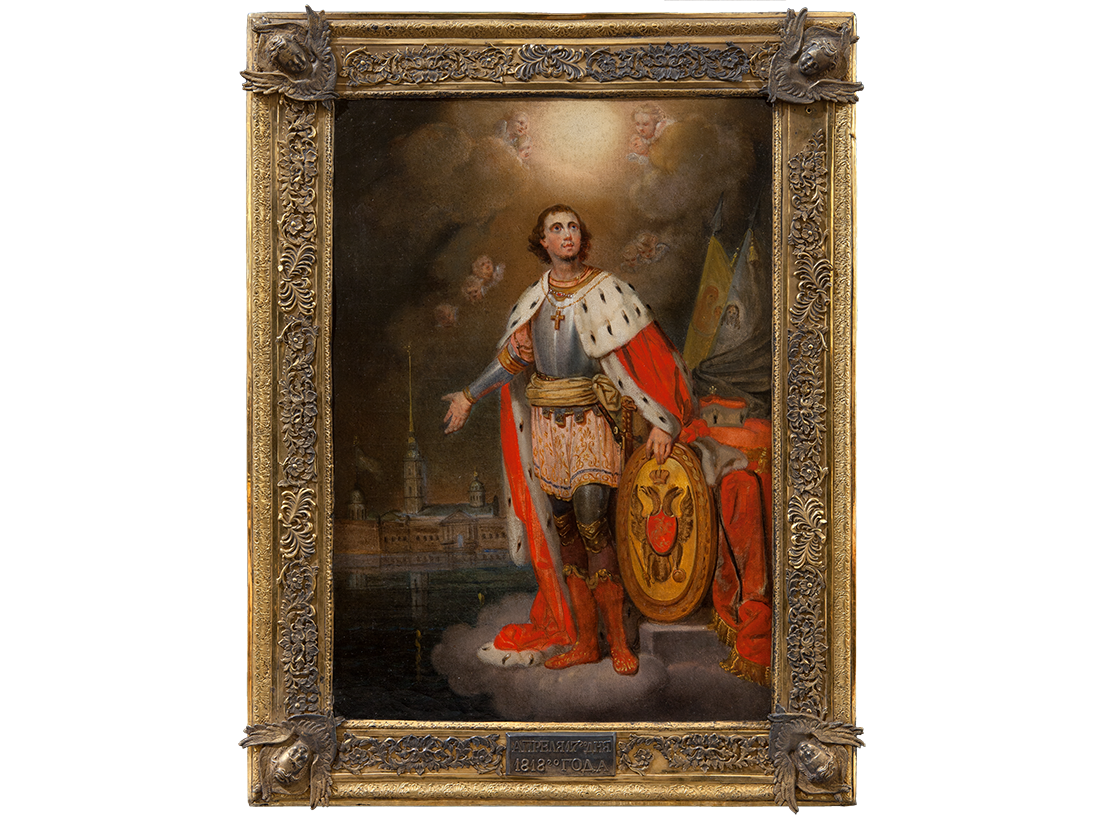Saint Alexander Nevsky

According to the Museum tradition, this rare memorial icon is called “measure icon of Cesarevich Alexandre” (later Emperor Alexander II the Liberator).
The icon has a metal frame with a little plaque on it with the date of birth of Grand Duke Alexandre Nikolayevich – “April 17, 1818”.
The firstborn of Grand Duke Nikolay Pavlovich (later Tsar Nicholas I) was born at the Bishop’s house of the Kremlin Chudov monastery and he gave joy for parents and hope for the dynasty. Before this moment none of the five sons of Paul I had a boy to ensure the succession to the throne. The baby was named after his triumphant uncle Alexander I and “according to a pious tradition” he was offered a measure icon of his patron saint.
Making a “birth” or “measure” icon was one of the old orthodox traditions in Tsar’s family since the 16th century. A newborn child was measured, according to the “measure” a wooden board was cut and an icon painter made the image. As Nicholas I wrote in his Notes, he had learned this custom from his grandmother Empress Catherine II who had revived it in the Imperial family. In fact, the height of the icon is 56 centimeters, the same as the height of the baby.
As a rule, measure icons were kept in private rooms of their owners.
On the icon, which is similar to a painting, is depicted St. Alexander Nevsky in the so called “postPeter’s” (after Peter I) iconographic style. The Saint is presented in knight’s armor, with his attributes of power, with Peter and Paul fortress as a background. The face of Holy Prince is sort of similar to Peter I than to a traditional icon image of Alexander Nevsky.
The new iconography was not random. In 1724 Peter the Great issued an edict prohibiting from painting the Saint Right-believing prince like an old man in a monk's robe but determining his image of a prince and warrior. From the 18th century Alexander Nevsky was honored on state level as a saint patron of Imperial Russia, its rulers and its new capital on the banks of the Neva.
Almost a century later, this image was made in the spirit of a new age. Some researchers believe that a painting by Vladimir Lukich Borovikovsky (1757–1825), a well-known artist of the time, was the prototype for this icon.
The inscription on the icon case records that this is an “icon in the size of the birth height of the successor to the throne, cesarevich Alexander Nikolayevich”. “The Highest present from Emperor Nicholas to Alexander Cadet Corps of Brest”.
In 1841 the successor to the throne, cesarevich became chief of a new outpost school in Brest Litovsk by the petition of local noblemen. Emperor Nicholas I agreed and made significant gifts to the school. The icon of St. Alexander Nevsky was among them. With this icon Cesarevich blessed the students at the opening of the school in 1842.
After the Brest Cadet Corps was dissolved in 1863, its memorable items including the icon were handed over to Alexander Military School in Moscow. In 1909 an order was issued to transfer all the ancient relics of the Brest Corps to the Saint Petersburg Alexander II Cadet Corps, which inherited the history and the traditions of the Brest School. After the revolution imperial military institutions were abolished. Fortunately, the memorial icon wasn’t destroyed, it ended up in the Museum Fund and since 1926 in the collections of Historical Museum. The inscriptions on its case helped the full attribution of the icon.
